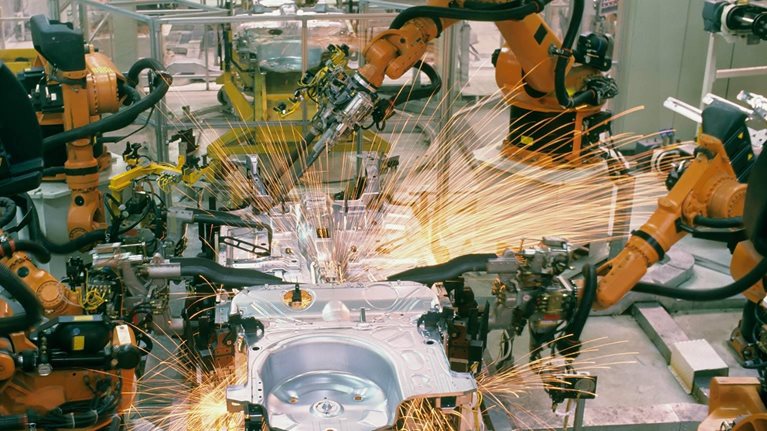The manufacturer’s chief talks with McKinsey director Katy George about skills, costs, and the supply-chain challenges of transforming production in an age of emerging-market growth.
Timken, the iconic manufacturer of bearings, came into being in the era of Henry Ford and the birth of the US automobile industry. For much of the company’s 113-year history, it made a single product. But in the past ten years, under CEO James Griffith, Timken has transformed itself into a $5 billion diversified industrial corporation and built virtually all its new plant capacity in Asia, and in the last year the company exported $660 million worth of products from the United States to emerging markets. “We have had to change the markets that we serve, we’ve had to change the products we’ve served, we’ve had to change the geographies we’ve served—and that’s required a radical change in the human face of the company,” Griffith says.
Timken’s journey is a microcosm of the dynamics and risk-and-reward opportunities facing manufacturers of all stripes in a new manufacturing era marked by the surging growth of emerging markets and their middle-class consumer base. Where in the value chain should an old-line manufacturer focus? How should companies make location decisions that balance the need for skills against the pressure for low costs? How does a global company seamlessly bring together operations and the supply chain in an increasingly volatile global economy?
Griffith and McKinsey’s Katy George explore these and other critical questions facing manufacturers today in a wide-ranging interview that challenges the conventional wisdom about manufacturing’s state in developed nations and its implications for growth. The transcript below is an edited version of the discussion.
Interview transcript
Creating value
McKinsey: You’ve been CEO of Timken for ten years and president for a couple of years before that. What’s changed the most in the state of global manufacturing?
James Griffith: It’s interesting, from my perspective. And I really look at it from a 30-year perspective. There have been a series of waves that changed the world of manufacturing. The first one was in the ’80s. The Japanese came to America, and the world globalized. Then in the ’90s, the American consumer rose and took advantage of that globalization by buying things from China.
What that caused then in the 21st century was the rise of the middle class of China, which has now given an opportunity—for those of us that make equipment for infrastructure— to sell on a global basis. Timken is 113 years old. We were founded by an inventor who invented a tapered bearing with the idea that he would help mechanical power transmission.
For a hundred years, all we made was that bearing. And as we entered our second century, the 21st century, we had to go back to the fundamental value that the company creates, and that is we make machines more reliable. And we have had to change the markets that we serve, we’ve had to change the products we’ve served, we’ve had to change the geographies we’ve served—and that’s required a radical change in the human face of the company.
McKinsey: You mentioned that one of the big changes has been the growth in emerging markets, from a consumer-class perspective. So how has that changed Timken’s strategy? What have you done in China?
James Griffith: I can recall when I was flying to China one time and I heard that they’re going to make 18 million cars this year. I thought, “Well, this is a megachange.” You really have to step back and say, “Where in that value chain do you create value?” And for a company like Timken that was founded with Henry Ford and the US auto industry, you would think the answer is obvious—you’d sell to the carmakers.
Except we recognized that our value was much stronger up the value chain, from the miners in Australia, running the big, heavy drag lines and heavy trucks, to the steelmakers and cementmakers in China. And so, as we went to Asia, we executed a major shift to become a diversified industrial company, and actually have chosen not to play in the auto industry at all in China.
And so when we looked at the auto industry, we recognized that we make something that creates a more reliable product. Well, we could make a car last for a million miles, but nobody cares. On the other hand, if we can make a 400-ton truck go 8,000 hours instead of 4,000 hours between major rebuilds, that’s of incredible value.
We recognized that that’s where we were, where the applications were the hardest, the dirtiest, and the most-challenging. Those were the industrial markets, those were the infrastructure markets. And interestingly, where did the infrastructure get developed in the last decade? In Asia. So that’s been our fastest-growing market in the world.
On my watch, in the past ten years, virtually 100 percent of our new plant capacity has gone to Asia. And yet, last year in 2011, we exported $660 million worth of product out of the United States to those markets, because we went and we learned how to play in those markets. And that drives the demand for American goods and allows us to employ 11,000 people in the United States.
Being ‘seamless’
McKinsey: How has your global footprint evolved? How do you think about the role of different countries as part of your global footprint?
James Griffith: When we started with what we call our transformation, we started with the fundamental that we had to be global. And so for us, doing business means, for example, if Kunming Iron & Steel is putting a rolling mill in, we’ve got engineers there working with them. We’ve got engineers in Germany working with the rolling mill manufacturers. We’ve got a design center in Romania. We’ve got an application engineering center in Canton, Ohio. And they’re absolutely seamless.
If we’re absolutely seamless across the world, then we translate value to the customer. And the bearings might come from Romania. They might come from America, or they might come from China. We manufacture all over the world.
McKinsey: What have you done internally to make that process seamless, to make the global interconnections work well?
James Griffith: We just get people to start working with other people, even when we acquire companies. We acquired a company in Ploiesti, Romania, that was a communist large-bearing manufacturer, privatized it, and put the best technology in. We discovered we had a great group of engineers there.
So instead of thinking of it as just a manufacturing place, it’s our large bearing design center for the world. And once you get that and people around the world realize they can take a lead in that, then the seamlessness just happens. It’s great people working together around the world.
Skills, not costs
McKinsey: You talked about skills and the importance of skills in competitiveness. We saw [in our research] that in most economies, there’s a mismatch between the skills that are required for modern manufacturing and the skills that are available.
James Griffith: When we look for a place to manufacture, we look for three things: We need to be in a place that’s got a significant market for our product. We need to have access to raw material. And we need a high-skilled workforce, because even the people who run the machines are dealing with CNC1 controls, computerized process controls, and fairly complex math, just in order to understand the tolerancing of the product. So we start with the idea that we’re going to go someplace that’s got a good educational program. Then we invest in it. We invest as a company. We invest as individuals to build that capability.
McKinsey: You mentioned three different things that you look at, when you think about the geography for manufacturing. In none of them did you mention labor cost. So how do you think about labor cost? How do wage differentials around the world factor into your manufacturing strategy?
James Griffith: I inherited a company with a strong North American and Western European manufacturing base. Over the last ten years, we’ve added a very strong, Eastern European, Indian, and Chinese manufacturing base. But we added it not because it was low labor cost, but because those were the markets that were growing; those were where we needed new capacity.
And over time, we try to manage a natural hedge from a currency point of view, so that we balance what we manufacture in a particular currency region with the markets in that currency region. For us, people skills are far more important than people cost, from that point of view. We opened a plant in Chennai, India, five years ago. And we did it with a complete Indian workforce, top to bottom, because our most senior people in India now have 20 years with us.
Innovation
McKinsey: What role has innovation played?
James Griffith: When we started our transformation, one of the things we recognized was that our knowledge about mechanical power transmission was unmatched anywhere in the world. It’s based on a century of investments in R&D and technology. What we also recognized was that we had become rigid in how we took that knowledge to market.
And so the majority of our innovation has been around how you change business models to unlock the value of that technology for a customer. The rail industry is probably the best example. We invented the wheel bearings for freight cars. We’ve incrementally changed them over time, but the fundamental design hasn’t changed for 50 years. And 50 years into that product line, you don’t make very much money making the product.
In the middle ’90s, we bought a company that remanufactures them. And today, 75 percent of the global revenue in our rail business is in remanufacturing—a service we provide to the customer that gives them a lower cost of use and greater security, or safety on the rails, but actually takes away the volume from our manufacturing base.
McKinsey: It’s interesting, because one of the things we looked at [in a recent McKinsey report] was the blurring of manufacturing and service jobs. But what you’re describing is that it’s manufacturing and service together. And service is a more important component of what you do.
James Griffith: Our first major customer in China was a company called Shanghai Heavy Industries that makes coal pulverizers for electrical power generation. We developed with them in China; now they’re exporting coal pulverizers to Indonesia. And we’re building a service base to provide the Indonesian power generators a lifetime of value.
We have a steel business. It doesn’t sound very innovative until you recognize that, in our steel business, 30 percent of what we sold this year didn’t exist five years ago. In this case, it is technology applied to a customer’s application, creating something that doesn’t exist. In the rail industry, it was a service.
In the aftermarket, it’s building a broader portfolio of product and having on-time delivery that’s better than anybody else in the world. Again, it starts with the customer. What creates value for the customer? And then we just innovate backward to create the value stream that brings it.
Risks and opportunities
McKinsey: Well, one of the other trends that we’ve looked at in manufacturing was the increase in volatility and the need for companies to be more agile. How has that played out at Timken?
James Griffith: The issue of volatility is something we’ve worked incredibly hard to deal with. We do it with contractual terms, with our customers in the steel business, for example. They take the volatility of raw material prices, which we deal with. We deal with it in the way we structure our workforce. In all of our plants, we try to do a mix of what we call “fixed,” permanent Timken people and a contingent workforce that allows us to deal with it. And we’re open with our people.
The other piece then, from a market portfolio point of view, is that we have worked very hard to move ourselves from an OEM market. The capital goods market is what drives a lot of volatility of demand, whereas the aftermarket is much less volatile.
And so if you looked at the acquisitions that we’ve done over the past five years, virtually all of them are in this aftermarket space. We’re trying to take some of the volatility of demand out of it, so that our people aren’t impacted so dramatically by that. And to put it in perspective, our industrial aftermarket when we started the transformation in 2000 was around $200 million. Today, it’s about $1.2 billion; that’s a growth of six times.
It was one product, because that’s all we manufactured on the OE basis. Today that product is less than half of what we sell in that market, as we’ve grown the aftermarket distribution and the aftermarket services piece, which is a lot more stable than the base, historic OEM business.
McKinsey: Earlier you talked about how important it was to create more interconnection around your own internal global network. So how does that interconnection work with your external partners and customers?
James Griffith: When you think about the integration of the supply chain, that’s a skill Timken has had to learn almost from scratch in the last 15 years. The historic Timken Company bought scrap, made its own steel, made all the components that went into bearings, and shipped them to the marketplace. So it was all inside.
Today, in China, we purchase more than 60 percent of the value of what goes into it. And again, we reach out and deal with our supply-chain partners as if they’re family. And in many cases, they are family companies. We’re a family company. And at the top of the company, we know the principals. We work with them on their investment strategies. We work with them on the technology that they use. And that translates to a much more flexible supply chain, where we all know what happens in the ups and downs.
McKinsey: What do you see as the biggest threats to your model and to your competitiveness?
James Griffith: How do you find the people, on a global basis? And then how do you balance what it takes to be the same, to be common, on a global basis, and yet respond to the individual needs of individual markets? Finding that balance, from my point of view, is the biggest challenge. The beauty is that when you find really good people, they do it naturally. And hence, finding the right people, getting them properly trained and educated in the Timken values and the Timken system, is the number one challenge for us and the number one opportunity.


